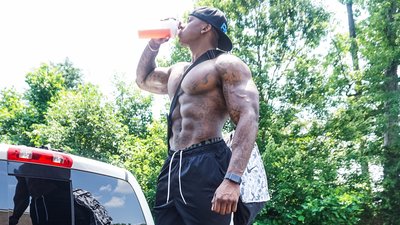In a world where so many people are looking for the easy route to a new body, Kieon Dorsey wants to be an ambassador of taking the hard road. And just to make sure there's no confusion, he even named his personal training business “No Struggle, No Progress.”
While growing up in Raleigh, North Carolina, this RSP-sponsored athlete learned this lesson the hard way. He went to battle with the older kids in his neighborhood on the basketball court and football field, and even though he was younger and smaller, they never took it easy on him. He knew he had to grow, so he did.
Today, he can’t thank them enough for making him stronger and resilient in the face of any challenge.
These are his six main mantras of strength, all of which he relied on to forge his own fitness-model physique and help others achieve their personal transformation goals. None of them are easy … but as Dorsey preaches, it’s that struggle that will yield incredible results in the end.
1. Time Under Tension Is King
In training, the time under tension, or “TUT” for short, is the amount of time your muscles are put under load during a set, and in total during a workout. The easiest way to add it is to go slow and make each rep actually last a little longer. And the easiest way to cut it down, and cheat yourself of results, is to hurry through reps or use momentum to move the weight.
“You need to allow your muscles to feel the brunt of the weight,” Dorsey instructs. “Instead of pushing the weight as fast as you can to just get reps over with, you want to control it. Don’t let it control you; own it!”

If you're relatively new to the gym or coming back after a time away, it can be easy to think you just need to "get your reps in" one way or another. But Dorsey advises taking the opposite route: make each individual rep count. One surefire to do this is to add a pause of just 1-3 seconds at the most difficult point of, say, a squat.
“Paused reps immediately break the momentum of the lift and rely on strength alone, while simultaneously increasing the time under tension,” Dorsey explains. “This puts the working muscles under more stress, breaking down more muscle tissue that will maximize your strength gains. It'll make you a better squatter, but it'll be a struggle.”
2. Don't Forget The Strength Sweet Spot
It can be easy to keep the focus purely on appearance goals like muscle gain and fat loss, and only work out in that "style." The textbook approach to build muscle, for instance, is rep ranges of 8-12 or slightly higher, along with rest periods as short as 30-45 seconds.
But don't forget that what you're doing goes by the name of "strength training!" Whatever your goal, being just a little bit stronger would probably help you achieve it. Sometimes, you should put your focus there. It can be just a certain move or two—squats and deadlifts, anyone?—that you perform at a lower rep range than others, and really focus on mastering at a higher weight.
“You don't have to go crazy with low-rep training," Dorsey advises. "It's good enough to keep those your working sets to 4-6 reps and rest 3-5 minutes between those sets." This way, you allow your body’s short-term energy systems to fully recharge, allowing you to get solid reps with weights of around 85 percent of your one-rep max. Sure, lifts in the 1-3 range have their value, but for most people, they just end up being counterproductive and risky.
Don't know what your one-rep max is, you say? That's OK. Plug a weight you can handle for 4 or 5 clean reps into a 1RM calculator, and it'll give you an accurate enough idea of your 1RM, with a fraction of the injury risk that goes along with actual 1RM testing.
3. Make A Big Drop After Strength Work
Dropsets are a common technique among bodybuilders, and Dorsey says they can even play an important role after your low-rep strength work. But how you do them will be slightly different than the traditional bodybuilding style.

In a typical drop set, you’ll rep until you can’t do another rep with good form, then lower the weight 20-30 percent and do more reps, again until failure. Plenty of lifters will even take further drops from there, maybe even "running the rack," where you make incremental steps all the way down to the lightest dumbbells.
Dorsey recommends a slightly modified approach: a single back-off set. “After you’ve nailed your reps in your working sets, drop the weight by more like 30-50 percent, and repeat the movement until failure,” he says. “This way, you’re not overdoing the reps with multiple drops. You'll still build strength but in a way that also boosts your muscle growth and fat-loss efforts."
4. Force Yourself To Go Further
A few weeks or months into consistent training, you might think you have a pretty good idea what your capabilities are. You can handle a certain weight for a certain amount of reps, check the box, and then walk away and do the next thing on the list.
Or do you? Dorsey says this moment is exactly when a good training partner or trainer would smash your expectations with a few forced reps. Forced reps are a powerful intensity technique that can take you just beyond momentary muscle failure—exactly what your hormones needs to prompt a growth response.
“Forced reps push you past the point of fatigue,” Dorsey says. “The spotter offers slight assistance on the positive portion of the last few reps of a set after you reach a point you can’t finish a rep on your own. After 2-3 forced reps, you’ll reach another level of failure … a.k.a. Jell-O!”
Forced reps aren't going to be helpful or advisable for every set of every movement. But on the last set of a movement, or the last set of the day, or just for an extra unexpected challenge, they can be just what the trainer ordered. Along with helping add muscle and perhaps a little strength, they can also boost your mental fortitude, erasing any fears of handling a demanding weight in a weakened state.
5. Don't Say No To Food, And Say Yes To N.O.
Nutrition can seem complex, but it boils down to a simple equation: input = output. “If you want to get stronger, you have to eat stronger!” Dorsey says. “Nothing changes if nothing changes. You can’t eat like a bird if you want to be a beast. You have to make responsible and smart choices with your diet. This includes what you eat, how much you eat, and when you eat. Take them all equally seriously.”
This doesn't mean you have to count calories or get crazy with the food scale, but consider it a call to at least be aware of where you're at. That can be as simple as tracking what you eat now for, say, a week with a food-tracking app, and comparing it to what a nutrition calculator says is appropriate for your size and goals. The results could be eye opening.

Supplements are a must too, according to Dorsey, but not all of them. “You want to make sure you have the necessary tools for your body to ramp up energy and strength and repair muscle tissue," he says.
For him, that starts with creatine. The benefits of this performance booster have been shown again and again: muscle growth, better workouts, greater endurance, and better recovery. For Dorsey, it's akin to a performance vitamin.
His other priorities are supplements that have been suggested to boost production of nitric oxide, or N.O. High levels of this crucial chemical compound has been suggested to delay fatigue, support blood flow to muscle tissue, and improve workout recovery.* Any lifter will tell you it's also great for getting serious pumps from those back-off sets and forced reps.
You can plenty of NO-boosting ingredients from a solid pre-workout. But Dorsey also takes agmatine sulfate on the side to further raise production, along with an intra-workout blend containing BCAAs and another proven NO-supporting ingredient, citrulline malate.*
None of these tips are revolutionary. They're just the type of rock-solid advice that you'd pay a trainer to receive—but that's free this time. “Once you've got a few key ideas to build around, just trust the process and give your best effort," Dorsey says. "Do that, and the results will always show progress."

